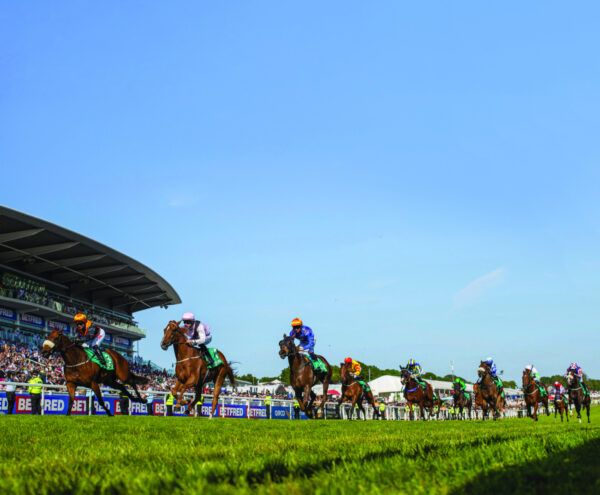The Turf: The Race For Glory
British racing is unmatched anywhere in the world says our man on the inside track, Colin Cameron

By Colin Cameron
October 8 2024
There’s a sport where Britain can truly claim primacy, and that is horse racing, the sport of kings. We have the best jockeys and trainers; top-ranked nurseries for breeding and raising the stars of tomorrow; and stables where excellence is honed for victory on the track. Speaking of which, Britain boasts racecourses that represent the ultimate equine challenge, starting with Epsom. Tesio, the legendary Italian breeder of thoroughbreds, including the mighty Ribot, sums it up best of all: “Racehorses exist because the selection of them has depended not on experts, technicians, or zoologists, but on a piece of wood: the winning post of the Epsom Derby.” The thoroughbred, as the name suggests, is the ultimate racehorse, bred here over centuries to optimise speed and stamina celebrated on racecourses all over the world. For this, everyone owes a nod to Albion. The significance of Epsom is key to why British racing is the best anywhere. The track is like no other: at the beginning, a steep rise to a sweeping turn; then a home straight with a fierce camber that makes acceleration only possible for horses with perfect balance. A location like this sorts the wheat from the chaff. Having proved his supreme worth, the Derby winner can, at stud, then become a cornerstone of future generations. By contrast in America, every track is a standard configuration, with races run anticlockwise most often on sand-based surfaces. The greats — such as Secretariat, winner of the US Triple Crown — excel, of course, but without needing to show real versatility. The Kentucky Derby? Groundhog Day. At Epsom? Within a furlong, runners have been challenged more to show a combination of speed and balance than at racecourses anywhere in America. So many racing countries in the world take this easy path of dirt racing around the same degree of turn. So ‘trilby’ to the likes of Australia, which along with some other notable countries, favours grass and circuits with traits that are far from universal, nationwide. Ascot, Perth is a legacy of ‘Poms’ arriving and seeking to establish some traditions of the mother country, including the challenges of different terrain. So points for that…
Another reason British racing is the best in the world is because rules around the usage of equine drugs are the strictest anywhere. Some of Australia’s most burly speedsters are almost too good to be true and simply too well developed for this to be how Nature intended them. The steroids used to bulk them up during their formative years are no longer detectable by officials here when they eventually come to race. The work strengthening the frame and muscle density has long been done before they even reach our tracks. This matters, because such meddling with medication corrupts the breed’s gene pool. Horses that have excelled at the track on the back of some ‘juice’ then retire to stud without having the real, raw talent and physical attributes that should be present if bloodlines are going to be enhanced. Indeed, any frailties disguised by whatever comes in an unscrupulous vet’s needle then become established in the herd, which is correspondingly weakened. By comparison, Britain’s breeding stock remains comparatively undiluted, and much the better for this. This includes horses sold at auction. (Did I mention Britain has the most established and respected auction houses, such as Tattersalls?) ‘Buy British’ never rang so true and the world understandably does, spending hundreds of millions every year at our bloodstock sales and in private deals.

Millions are spent to win at the track, too. Not least in the US, where every autumn our American friends stage the Breeders’ Cup. They modestly refer to this as ‘the world championships’ of racing, which rotates among the most prestigious venues, coast to coast. At least in this case, and in contrast to baseball’s World Series, other nations do take part: British runners go to wherever it is staged. They gift their hosts home advantage, sometimes including the surface under hoof. The configuration of the track is of course always familiar to those who have not crossed oceans to race. And yet, the winning role of honour listing visitors from the mother country who have defeated locals stretches back to 1984, when the Breeders’ Cup was first held. Keep going round the globe to The Melbourne Cup, the only other serious rival to Britain’s Number One world ranking. It is ‘the race that stops the nation’. Horse transportation brought the event into reach of runners from the northern hemisphere about 40 years ago and since then, British-bred winners have won five times. Bart Cummings, the stalwart Australian trainer known as ‘the Cups King’, who has claimed no fewer than 12 wins in the race, once complained that runners from the northern hemisphere had no place in Australia’s top race. Whingeing Poms? Native whingers, rather. And so to our neighbours just across the Channel. The French racing season is structured with a finale in Paris on the first Sunday of October, namely the Prix de l’Arc de Triomphe. Our runners who contest the event have put in a good few more hard yards during the season chasing our own posts contested between May and the end of September. Sometimes the Arc is no more than an afterthought after a long summer and ahead of retirement to stud, in comparison to the best of France, where trainers target the race from almost the f irst moment a horse is foaled. Yet in the history of the Arc, which was first run in 1920 — the year, incidentally, that was won by a British runner — there have been a total of 16 successes for the visitors. The Epsom Derby, run since 1780, has seen just ten wins from France and none from Australia or America. In truth, few overseas runners can breach the citadel of our mother country. British racing? It’s the sport of kings of the castle.
